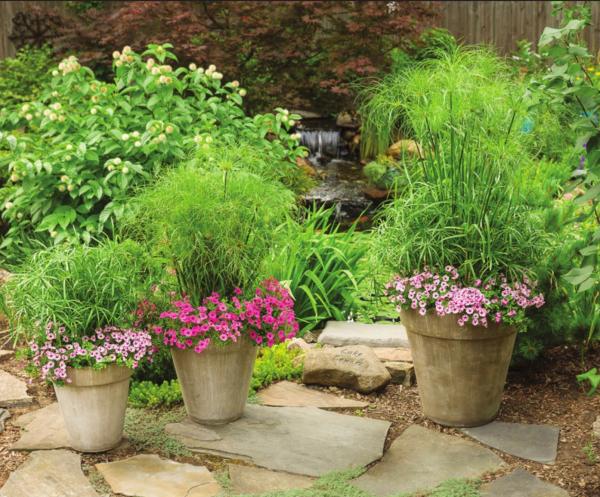The Tut Family Offers a Regal Performance In the Landscape or Containers
The Azalea Bowl at Callaway Gardens is one of The Garden Guy’s favorite places, even when the 3,000 plus azaleas aren’t blooming. The seasonal color and serenity will have you energized in short order. Such was the case recently when my wife Jan and I became mesmerized with their plantings of flowers, and foliage in combination with the graceful King Tut papyrus.
It has been 7 years since I last wrote about King Tut papyrus grass. It needs to be much more widely planted, as the thriller in mixed containers and in the landscape where it creates a mood that is unparalleled in the plant world. King Tut offers an incredible fine leaf texture with its foliage born on top of a cane, reed or stalk that is reminiscent of bamboo. It has won 136 awards across the country including Texas which speaks volumes to its summer durability and usefulness in design.
In those 7 years since I last wrote about King Tut, Proven Winners has added a Baby Tut and a Prince Tut. All of them will transform a mixed container like few other plants can do. They leave me hoping a Queen Tut might be in our future, but I digress. Know this, these plants leap off the shelves in the spring so get ready to rumble.
When I was Director of Georgia’s Columbus Georgia Botanical Garden, we used King Tut papyrus, Cyperus papyrus, from Egypt and the umbrella palm, Cyperus involucratus, which is a close relative from Madagascar. The last did survive the Columbus GA winters and took a little cutting back to keep it in its allotted space.
King Tut and Prince Tut are both Cyperus papyrus and cold hardy in zones 10 and warmer. This means if you live in an area that freezes you will grow it as an annual like you do so many other ornamental grasses. Believe me when I say they are worth every penny. Baby Tut is a dwarf compact selection of Cyperus involucratus reaching 24-inches and wide. It will be cold hardy in zones 9 and warmer so if you live in these zones you can expect it to get happy and show its aggressive side if grown in the landscape.
Compared to those growing along the Nile River, the King Tut is a dwarf in some aspects reaching only 4 to 6-feet. They gracefully arch over and give a tufted or hairy appearance with their umbrellas. Remember Moses being rescued in the bulrushes? That is papyrus. In Columbus we grew them in combination with Compact Electric Orange SunPatiens and the Red Abyssinian banana. Prince Tut is also award winning but much shorter reaching 30 inches tall with a 36- inch spread but offers the same graceful habit. These grasses thrive in full sun to part shade, sloppy wet or simply fertile soil. They grow rapidly, your 1-gallon spring planted container will look as though you used a 10-gallon specimen in the fall.
If you are growing them in a water garden try growing them in a sunken container. This will manage any unwanted spread.
In mixed containers you could hardly find a better thriller plant. Since they are green, they obviously go with any color scheme you are creating. At Callaway Gardens they used orange SunPatiens and two colors of ornamental sweet potatoes.
The Tut family of papyrus are must-have plants whether you want to use them in the landscape or in containers. The design possibilities will be endless, IF, you make sure you are among the first in line when your garden center gets in the shipment. Follow me on Facebook @NormanWinterTheGardenGuy for more photos and inspiration.


